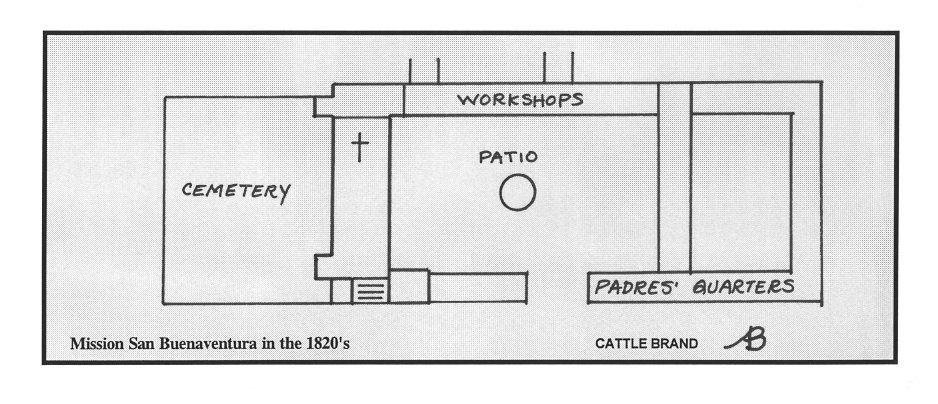| ||||
|
| ||||
|
MISSION
SAN BUENAVENTURA
225 East Main Street
Ventura,
CA 93001
Established: March 31, 1782
By: Father Junípero Serra, Franciscan missionary, President of the missions.
Order: 9th of the 21 missions.
Location: 70 miles north of Los Angeles, 25 miles south of Santa Barbara, near the ocean.
Named: For St. Bonaventure. Born John Fidanza in Tuscany in 1221, he is said to have been restored to health by St. Francis and to have exclaimed "O buona ventura," (oh, good fortune!), thus acquiring his new name. Also known as The Mission by the Sea.
California Historical Landmark No. 310
DESIGN OF THE MISSION
Church: 154 feet long, 40 feet wide; made of adobe bricks and stone. Tile roof. Tile floors.
Style: Traditional, distinguished by a unique triangular design on the façade (front), which may be a religious symbol representing the Holy Trinity. Another architectural feature is the side door, under a Moorish arch flanked by flat ornamental stone columns. The curved lines above the door may represent the two rivers that pass on either side of the mission. A heavy stone buttress is placed to the left of the main entrance to give support to the structure.
Walls: 6½ feet thick.
Bell Tower: Single tall tower, unusual because it is not symmetrical (the two upper sections are not centered on the base). There are five bells; the bell at the top, made in 1956 in France, has an automatic ringing system; four bells in the lower section are old, hand-operated (two dated 1781, one dated 1825, one undated). Topped by a small dome and a cross.
Mission Compound: The quadrangle was not large, but contained the usual living quarters, artisan workshops, and a well-kept garden. The Chumash Indians of the area preferred to stay in their own homes rather than move into the mission; some built their conical huts of willow poles covered with tule reeds near the Mission compound.
Mission Grounds: Mission was surrounded by orchards, vineyards, and grain fields; known for the abundance of fruits and vegetables produced, including tropical fruits such as bananas, coconuts, figs, and sugarcane. Pears were a specialty. Sailing ships stopped at the mission to replenish their supplies. In 1793, Captain George Vancouver noted the beauty of the gardens at this mission.
Water System: A reservoir and aqueduct system brought water from the Ventura River to the mission buildings and fields. One of the clay pipe aqueducts was seven miles long. Buenaventura was sometimes called the place of canals. The receiving reservoir was called Cabeza del Caballo (caballo is Spanish for horse) because the water came from the mouth of a stone horse-head.

EARLY HISTORY
1770 Father Serra wanted to establish the third mission at this site, halfway between the first mission (at San Diego) and the second (at Monterey), but did not receive permission of the Governor to do so.
1782 Mission site dedicated; Father Serra left Father Cambón in charge. Church and other buildings went up quickly with the help of the talented Chumash workers.
1790 Aqueduct system built to bring water across hills from river into reservoirs and a storage tank; water filtered by flowing through a screen.
1792 First church destroyed when poles and thatched roof caught fire.
1794 Construction started on a larger stone and adobe church.
1809 Stone church completed after 15 years of work; altar and paintings sent from Mexico.
1812 Church damaged by earthquake; bell tower collapsed.
1816 Church reconstructed with stone buttress for support and a double wall on the bell tower.
1836 Mission secularized, lands taken from the Catholic Church.
1842-43 Used as a parish church.
1845-46 First rented and later sold by the Governor.
1857 Earthquake damaged the roof; tile roof later replaced with a shingle roof.
1862 Mission returned to the Catholic Church.
MISSION SAN BUENAVENTURA TODAY
In 1893 the resident priest, Father Rubio, made extensive changes to the mission. He tore down all the outer buildings, enlarged the church windows and put in dark stained glass, covered the Indian designs on the walls with modern designs, removed the canopied wooden pulpit, covered the beamed ceiling and tile floors with wood, whitewashed the walls, and removed the Mexican altar.
For over 50 years, the mission church bore little resemblance to its original form. Restoration begun in 1957 has returned the church as much as possible to its 1812 condition. The windows were restored to the original size; ceiling and floors were uncovered, revealing the pine and oak ceiling beams and the tile floors. In 1976 a new pulpit was constructed from some pieces of the old one.
The church itself is all that remains of the mission compound. The fields and orchards have been replaced by busy city streets. An elementary school was built on the mission cemetery. The City of Ventura has placed a plaza across from the mission church entrance, so the view to the ocean is preserved. Portions of the aqueduct walls are visible several miles from the restored mission.
The mission museum exhibits the work of the Chumash people, who were noted for their excellence in boat building and wood carving. They also made exceptionally fine baskets that held water. Interesting items for visitors to see are the statue of St. Bonaventure in the center niche behind the altar, the old olive press that sits in a corner of the garden, and the two wooden bells. The only ones of this type known in California, the wooden bells are lined with metal and were used during special ceremonies.
